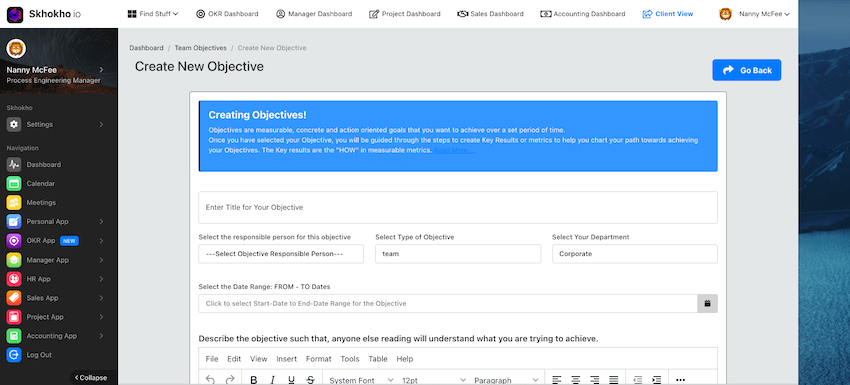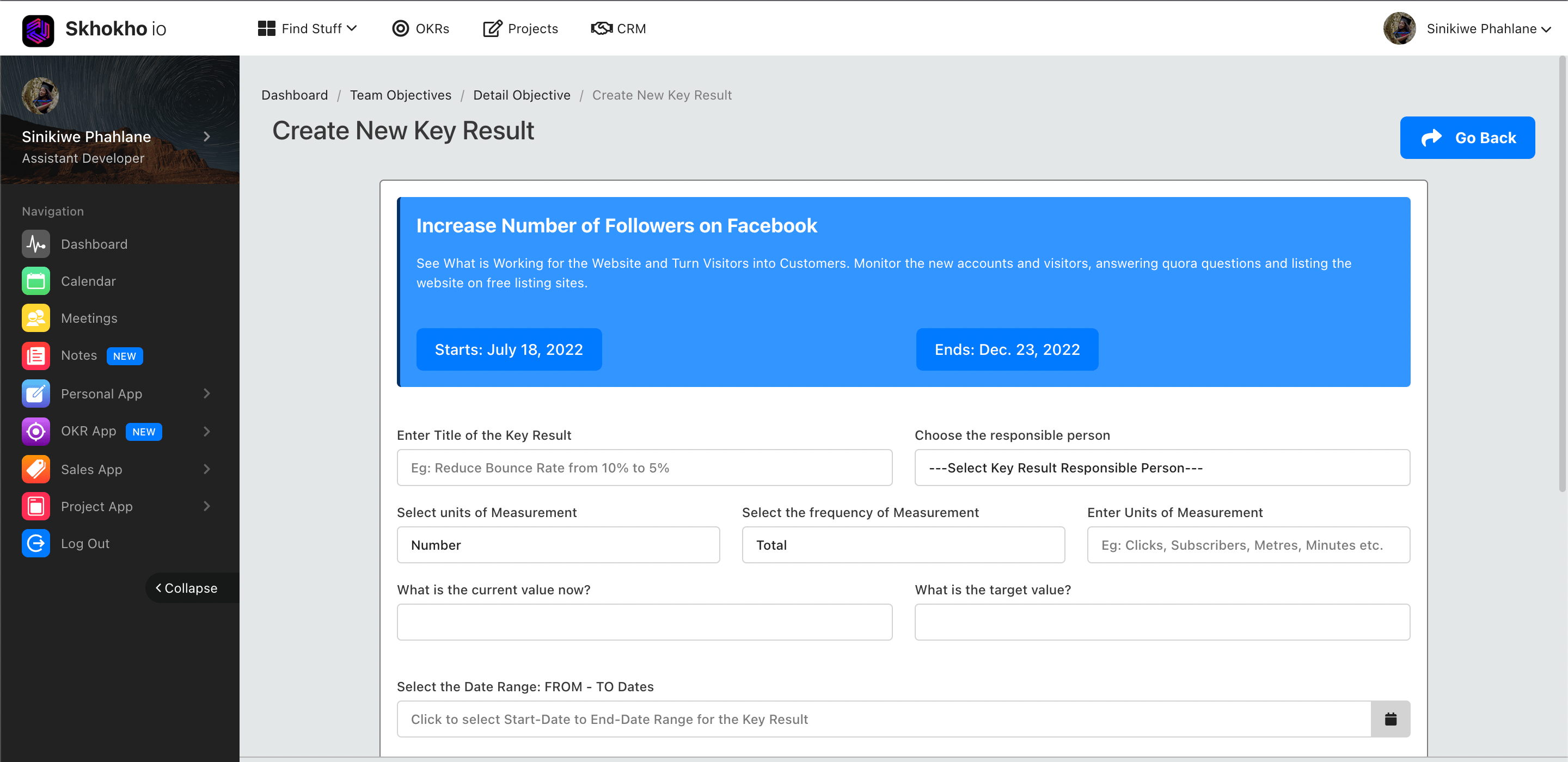Marketing OKRs: Tracking And Measuring What Matters
If you're in charge of marketing at your company, you know that it's important to set and measure what matters. After all, how can you measure your success if you don't have any goals to begin with? Marketing OKRs (Objectives and Key Results) are a great way to do this. This blog will explore Marketing OKRs, what they are, and how to use them in your own business.

We will cover the following:
- What are Marketing OKRs?
- Objectives and key results
- Why Marketing OKRs are Important
- 5 main types of marketing OKRs
- How to set good marketing OKRs: How do you define a solid marketing OKR?
- Some Tips For Success
What are Marketing OKRs?
OKR is the acronym for 'Objective and Results'. The objectives you are looking for and the key results are the ways that you can achieve the objectives. OKR (Objectives and Key Results) are a great way to measure your results and track your progress as a company. They provide a way to set goals and effectively measure their performance.
Marketing OKRs are a tool used by businesses to measure and track progress towards specific objectives. By setting measurable goals, businesses can more effectively track progress and ensure that everyone is working towards the same objectives. Marketing OKRs can help businesses to improve communication, increase transparency, and boost accountability and enforce commitment.
Marketing OKRs are objectives and key results that help organizations measure and track progress towards specific goals. OKRs can be used to track progress in any area, but they are particularly useful for marketing teams because they help to align team members around a common goal and ensure that everyone is working towards the same objectives.
They also help to hold individuals and teams accountable for their results and help to identify areas where improvement is needed. Marketing OKRs can be used to track progress across a variety of metrics, including website traffic, leads generated, conversion rates, and more.
Objectives and Key Results
Not sure what OKRs are? Here's a quick rundown: Objectives are the overarching goals that you want to achieve, while key results are the specific, measurable steps that you'll take to get there. For example, let's say your objective is to increase brand awareness. Your key results might be things like increasing website traffic by X% or increasing social media engagement by Y%.
The OkR, as its name suggests, is a two part methodology: objectives and key outcomes (OKR). – to create marketing objectives and measure their effectiveness. OKRs provide an effective goals setting framework linking all sides, upwards, downwards and sideways. All these alignments align with the entire company ensuring OKRs rise to the top of their respective companies' ladders. Marketing is of course very diverse with various components to achieve various objectives.
The benefits of using OKRs are numerous, but some of the most important include improved communication, focus, and accountability. With OKRs in place, everyone on the marketing team knows what they need to do to contribute to the company's success. And, because OKRs are measurable, it's easy to track progress and identify areas where improvements need to be made.
If you're not already using OKRs in your marketing department, now is the time to get started. Keep reading to learn more about how to set and achieve marketing OKRs
OKRs can help you measure how your business functions. They assist in tracking and prioritizing tasks that matter, which allows for quicker achievement of your goal than ever before
Why Marketing OKRs are Important
Setting and achieving marketing OKRs is important for any business that wants to succeed. Marketing OKRs provide a framework for setting and measuring progress and success in marketing initiatives. They help businesses to focus on the right goals, track progress and identify areas of improvement. Marketing OKRs also help businesses to allocate resources effectively and efficiently.

5 Main Types of Marketing OKRs
In general, OKRs fall into one of five categories:
1. Inputs: Marketing OKRs should focus on the inputs that are necessary to complete the task at hand. This could include things like budget, time, resources, etc.
2. Processes: Marketing OKRs should also focus on the processes that are necessary to complete the task at hand. This could include things like planning, research, execution, etc.
3. Outputs: Marketing OKRs should also focus on the outputs that are necessary to complete the task at hand. This could include things like leads, sales, conversions, etc.
4. Outcomes: Marketing OKRs should also focus on the outcomes that are necessary to complete the task at hand. This could include things like brand awareness, customer satisfaction, etc.
5. Project: Marketing OKRs should also focus on the project as a whole. This could include things like the timeline, milestones, deliverables, etc.
How to set good marketing OKRs: How do you define a solid marketing OKR?
Marketing OKRs should be aligned with the company's mission in order to ensure that the company is working towards its goals. The company's mission should be the guiding force behind all of its actions, and its OKRs should be no different.
Setting and achieving marketing OKRs is essential to any organization that wants to remain competitive. By setting specific, measurable, attainable, relevant, and time-bound objectives, marketing teams can track and measure their progress in a way that is aligned with the company's overall strategy.
A good marketing OKR should be; Specific, Measurable, Attainable, Relevant, and Time-bound.
1. Specific:
The goal should be clear and easy to understand. The company’s goals should always be realistic. This will ensure that the company’s employees are always working towards achievable goals and that they are not working towards goals that are impossible to achieve.
2. Measurable:
The goal should be something that can be tracked and monitored. This will ensure that the company can track its progress and that its employees are always aware of how close they are to achieving the company’s goals.
3. Attainable:
The goal should be ambitious but achievable. The company’s goals should always be achievable. This will ensure that the company’s employees are always working towards goals that they can actually achieve.
4. Relevant:
The goal should be aligned with the company's overall strategy. The company’s goals should always be relevant. This will ensure that the company’s employees are always working towards goals that are relevant to the company’s mission and strategy.
5. Time-bound:
The goal should have a specific timeframe for completion. The company’s goals should always be timely. This will ensure that the company’s employees are always working towards goals that they can be deliver within a reasonable time frame.
Marketing OKRs: Some Tips For Success
There are a lot of moving parts to any successful marketing organization, so it's important to have a clear and concise way to measure progress and success. One popular framework for doing this is setting OKRs, (Objectives and Key Results).

1. Identify the correct OKRs
The first step to setting successful marketing OKRs is to identify the correct OKRs. What are your marketing goals? What do you want to achieve? Once you have answers to these questions, you can begin to set your OKRs.
Example; Increase Social Media Followers. the best way to increase social media followers will vary depending on the platform and the audience you are trying to reach.
Possible OKRs:
- Use hashtags
- Post interesting and engaging content
- Run social media contests
- Engage with other users
- Promote your social media accounts on other channels
It is important to set and track OKRs that are related to the outcomes you intend to accomplish. For examples;
- Brand awareness OKRs: Increasing brand awareness is often a top priority for marketing teams. Possible objectives could include increasing brand mentions by X% or growing social media followers by X%.
- Lead generation OKRs: If generating leads is a key focus for your team, objectives could include increasing the number of leads by X% or the number of website visitors by X%.
- Sales enablement OKRs: Enablement objectives could include increasing the number of sales-qualified leads by X% or increasing close rates by X%.
- Customer retention OKRs: Retaining customers is essential for any business. Possible objectives could include reducing customer churn by X% or increasing customer satisfaction scores by X%.
- Revenue growth OKRs: Of course, a key goal for many marketing teams is to drive revenue growth. Possible objectives could include increasing total revenue by X% or growing market share by X%.
2. Set metrics
There is a difference between marketing metrics and marketing OKRs. There is, however, an intrinsic connection between them.
In order to measure the success of your marketing OKRs, you need to set metrics.
Using the example we mentioned above, "Increase Facebook Followers", The metric you need to measure is, "number 0f new followers you get". This may be recorded daily, weekly, monthly or quarterly.
3. Target marketing campaigns to OKRs
Once you have identified your OKRs and set metrics, you can begin to target marketing campaigns to these goals. By targeting your marketing campaigns, you can ensure that you are making the most of your marketing budget and effort.

How Skhokho Can Help
Skhokho OKR - Goal Setting, Management, Implementation Software
Skhokho okr system that helps your organisation get closer to achieving its goals, in a collaborative, intelligent and effective way. Skhokho will help you stay accountable and get stuff done.
Skhokho offers the following:
#1. Agile Goal Setting
Through Skhokho objective setting software, you can easily create OKRs and share them with everyone in your organization.
#2. Clear Key Results
By using the Skhokho OKR App, you can define up to five different Key Results for mapping the route from one place to another. A key result can be represented in numbers, percentages, or currencies. Those are measurable variables that you can influence to achieve your goals. There is a direct relationship between each Key Result and the underlying Objective.
#3. Goal Task Management
With the Skhokho OKR App, you can manage marketing objectives in the same way you manage tasks in projects. Keeping your entire team and organization focused on a single goal is easy with this tool. The key to achieving the underlying objective is to create tasks that drive a Key Result forward.
#4. OKR Dashboards
You can now track your OKRs in a visual format. Never miss any deadline again by using Skhokho. Skhokho comes with full OKR Dashboards for the team.
Get Started with Skhokho OKR System: Measure What Matters
The process:
Setting Marketing OKRs

You will have to enter the following information for the objective:
- Title
- Responsible person (i.e. John Doerr)
- Select - Team or Individual Objective
- Select the business department or business unit
- Select start and end date
- Description of the objective
The Key Result page will appear once you have entered your objective. Here you will need to enter a Key Result supporting your objective. A key result serves as a milestone towards achieving an objective.

You will then be required to enter the following information:
- The title of the key result (use a descriptive, specific and measurable title - eg: complete 10 interviews every month for 6 months).
- Choose a responsible person for the Key Result - Note this can be different from the responsible person for the Objective
- Select the Key Result measurement - The options are: (1) Number, (2) Decimal, (3) Currency and (4) Percentage.
- Select the frequency of measurement - The options are: (1) Total, (2) Hourly, (3) Daily, (4) Weekly, (5) Monthly, (6) Quarterly and (7) Annually
- Unit of measurement - This can be anything from kg, people, views to subscriptions. In our example you would enter "followers" as the unit of measure. Because you are measuring a number of followers.
- Enter the current value and target value for the Key Result. The Current value in this example would be the number of followers you currently have and the target would be whatever number you want to achieve.
- Enter start and end dates
- Write a description for your Key Result
Tracking Marketing OKRs
The first section of the page only shows the key result you clicked on and your objective:

The starting measurement, current measurement, and target measurement will all be displayed. The starting measurement will also be the current measurement when you first begin. The latest recorded value will be used as the current value when you update and add new measurements – check-ins.
For deeper explanation on Skhokho OKR App, visit this page; https://skhokho.io/objective_key_results_okr_software
For more information on how to set OKRs using SKhokho, visit this page: https://skhokho.io/documentation/okr/
Register today on Skhokho and enjoy 14 day free trial.









